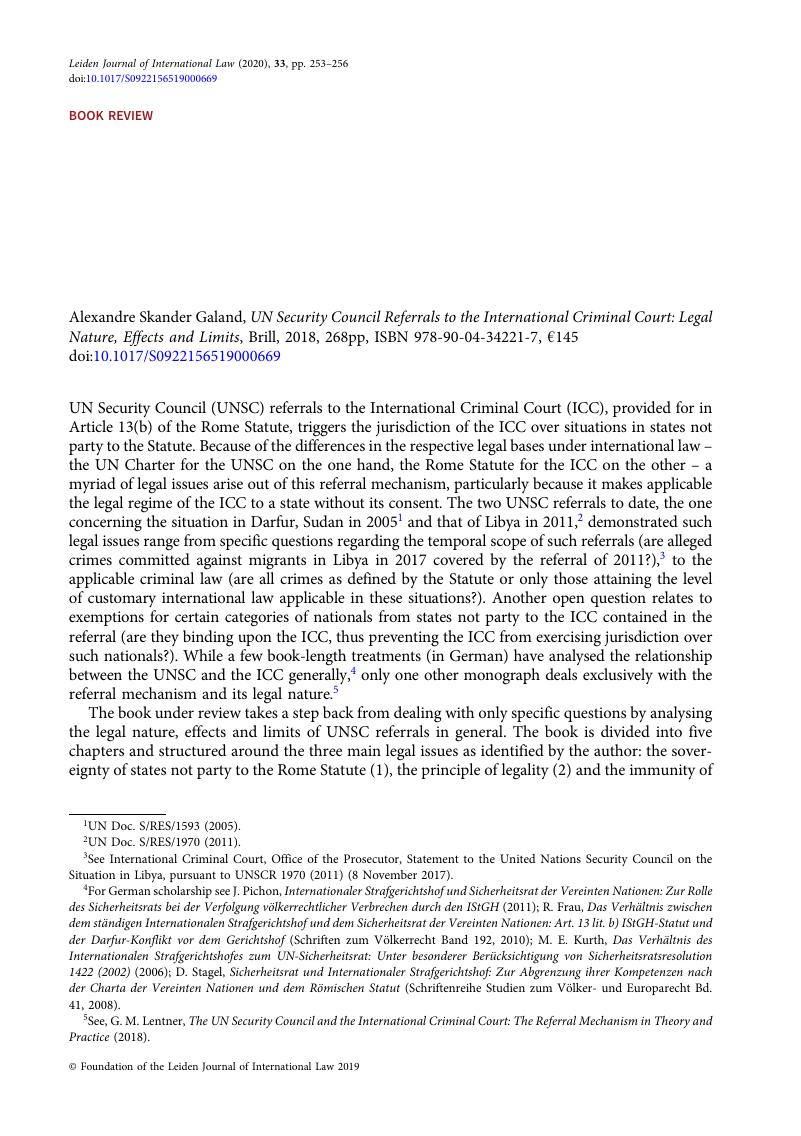No CrossRef data available.
Published online by Cambridge University Press: 25 November 2019

Danube University Krems, Dr.-Karl-Dorrek-Strasse 30, 3500 Krems, Austria [[email protected]].
1 UN Doc. S/RES/1593 (2005).
2 UN Doc. S/RES/1970 (2011).
3 See International Criminal Court, Office of the Prosecutor, Statement to the United Nations Security Council on the Situation in Libya, pursuant to UNSCR 1970 (2011) (8 November 2017).
4 For German scholarship see J. Pichon, Internationaler Strafgerichtshof und Sicherheitsrat der Vereinten Nationen: Zur Rolle des Sicherheitsrats bei der Verfolgung völkerrechtlicher Verbrechen durch den IStGH (2011); R. Frau, Das Verhältnis zwischen dem ständigen Internationalen Strafgerichtshof und dem Sicherheitsrat der Vereinten Nationen: Art. 13 lit. b) IStGH-Statut und der Darfur-Konflikt vor dem Gerichtshof (Schriften zum Völkerrecht Band 192, 2010); M. E. Kurth, Das Verhältnis des Internationalen Strafgerichtshofes zum UN-Sicherheitsrat: Unter besonderer Berücksichtigung von Sicherheitsratsresolution 1422 (2002) (2006); D. Stagel, Sicherheitsrat und Internationaler Strafgerichtshof: Zur Abgrenzung ihrer Kompetenzen nach der Charta der Vereinten Nationen und dem Römischen Statut (Schriftenreihe Studien zum Völker- und Europarecht Bd. 41, 2008).
5 See, G. M. Lentner, The UN Security Council and the International Criminal Court: The Referral Mechanism in Theory and Practice (2018).
6 A. S. Galand, UN Security Council Referrals to the International Criminal Court: Legal Nature, Effects and Limits (2018), 10.
7 Ibid., at 6.
8 Ibid., at 4.
9 Ibid., at 17 (footnote omitted).
10 Ibid., at 30.
11 Ibid., at 31–45.
12 The Prosecutor v. Omar Hassan Ahmad Al Bashir, Judgment in the Jordan Referral re Al-Bashir Appeal, ICC-02/05-01/09-397-Corr, A.Ch., 6 May 2019, para 115.
13 Galand, supra note 6, at 46.
14 Ibid.
15 Ibid., at 88.
16 Ibid., at 69–76.
17 Ibid., at 76–88.
18 Ibid., at 88.
19 Ibid., at 102.
20 Ibid., at 104–5.
21 Ibid., at 150.
22 Ibid., at 151.
23 Ibid., at 129.
24 Ibid., at 130.
25 Ibid., at 140–9.
26 The Court held that heads of state have no immunity under customary international law before international tribunals, see The Prosecutor v. Omar Hassan Ahmad Al Bashir, Judgment in the Jordan Referral re Al-Bashir Appeal, ICC-02/05-01/09-397-Corr, A.Ch., 6 May 2019.
27 Galand, supra note 6, at 166.
28 Ibid., at 200.
29 Ibid., at 212.
30 Ibid., at 214.
31 Ibid., at 222.
32 Ibid., at 9.
33 John Rawls, for example, distinguishes different conceptions from the concept of ‘justice’. See J. Rawls, A Theory of Justice (1999), 5–6. See also R. Dworkin, Law’s Empire (1986), 71.
34 Galand, supra note 6, at 75–6, 205–23.
35 Ibid., at 212.